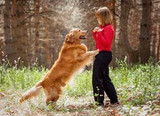Dog Behavior 101: Jumping

Understanding why dog jump up on you when they greet you is important dog behavior to understand.
This behavior can be corrected - but first, we should understand the reason dogs jump in the first place.
So - Why do dogs jump?
Dogs greet each other nose-to-nose and want to do the same with us. Since our noses are not at their level, they jump up to reach them. Dogs don’t use the same language we do, they cannot communicate with us in the same way. So we have to look at their actions and behaviors as their method of communication. Some people, however, find this objectionable.
Dogs that jump up can also cause injury or scare the visitor. The visitor’s reaction to the dog (whether it be fear or retaliation) would then serve to make the dog anxious about further visitors coming to the home.
How to Stop the Jumping Up
Jumping up is a natural greeting behavior but one that can be quickly prevented. You can stop dog jumping by following these simple guidelines:
- Reduce the emotional component when you arrive home. Avoid fast movements and loud voices. Ignore your dog until he is calm.
- Follow the Four on the Floor rule. Don’t touch your dog – and that includes pushing him off – until he is calm and quiet.
- Train a mutually exclusive behavior. Ask your dog to sit for all greetings and interactions with strangers and reward him with goodies.
- Leash your dog when guests come over and ask them to help you train by asking your dog to sit before rewarding him with attention.
- Put the behavior on command if you sometimes like the greeting but others don’t. Teach your dog that jumping up is only allowed with the word “Up!”

Safety
Many of us see no reason to teach our dogs not to jump up. We don’t mind, and if a friend or relative needs the dog not to jump, we simply put the dog on leash.
We get older, though, and our dogs age even faster than we do. Besides age, many physical problems can arise that make jumping up downright dangerous. At some point in your dog’s life, jumping will become a hazard to her. Your dog will live with less risk of pain if taught early on not to jump. The non-jumping dog’s life will include more petting and love, because it’s so much easier and more enjoyable to pet a dog who has four feet on the ground.
Practice Makes Perfect
It helps if you can set up situations to practice with your dog. For instance, if the jumping occurs most often when you come home after work, spend a few minutes several times a day coming and going. Don't make a big fuss over your dog and step back outside if it jumps up.
Praise and reward when your dog is sitting or standing on all fours. Behaviors that are rewarded tend to repeat and strengthen and this is scientifically proven.


